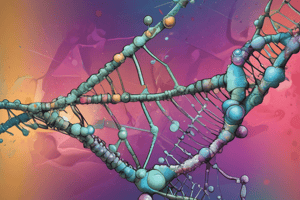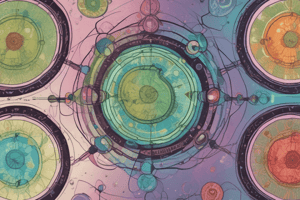Podcast
Questions and Answers
During DNA replication, what is the role of helicases?
During DNA replication, what is the role of helicases?
- Maintain the balance of base composition
- Unwind the double helix into separate strands (correct)
- Add nucleotides to the growing DNA strand
- Synthesize new strands by adding nucleotides
Which enzyme is responsible for synthesizing new complementary DNA strands?
Which enzyme is responsible for synthesizing new complementary DNA strands?
- DNA polymerase (correct)
- RNA polymerase
- Ligase
- Helicase
What maintains the balance of Watson-Crick base pairing during DNA replication?
What maintains the balance of Watson-Crick base pairing during DNA replication?
- DNA ligase
- Helicases
- Chargaff's base composition rule (correct)
- Primase
Which nucleotides are added to the growing DNA strand in a 5' to 3' direction during replication?
Which nucleotides are added to the growing DNA strand in a 5' to 3' direction during replication?
What is the function of DNA ligase in DNA replication?
What is the function of DNA ligase in DNA replication?
Which process involves the formation of an RNA molecule from a DNA template?
Which process involves the formation of an RNA molecule from a DNA template?
What is the primary function of proofreading mechanisms during DNA replication?
What is the primary function of proofreading mechanisms during DNA replication?
Which enzyme is responsible for transcribing DNA into mRNA?
Which enzyme is responsible for transcribing DNA into mRNA?
What kind of mutation results in a single amino acid change in a protein?
What kind of mutation results in a single amino acid change in a protein?
What is the correct order of the steps involved in protein synthesis?
What is the correct order of the steps involved in protein synthesis?
What are the components that form the backbone of the DNA double helix?
What are the components that form the backbone of the DNA double helix?
What type of chemical bonds hold the complementary base pairs together in the DNA double helix?
What type of chemical bonds hold the complementary base pairs together in the DNA double helix?
Study Notes
Molecular Basis of Inheritance: Understanding DNA Replication, RNA Transcription, Genetic Mutations, Protein Synthesis, and Structure of DNA
The field of genetics and molecular biology reveals fascinating insights into the structure and functioning of biological macromolecules that dictate hereditary traits and disease processes. To comprehend the complex interplay between the various elements involved in the molecular basis of inheritance, we must explore the processes of DNA replication, RNA transcription, genetic mutations, protein synthesis, and the structure of DNA itself.
DNA Replication
At its core, the process of replication enables organisms to reproduce their genetic information accurately. Chargaff discovered that the base composition in DNA molecules remains constant throughout the molecular weight range of the DNA molecule. This means that both strands of DNA contain equal amounts of adenine (A) and thymine (T), guanine (G) and cytosine (C), maintaining the overall balance of Watson-Crick complementary base pairing (AT and GC).
As DNA replicates, the double helix unwinds into two separate strands, with the hydrogen bonds breaking between the base pairs. Each original strand serves as a template for the formation of a new complementary strand. Enzymes like helicases facilitate unwinding, while DNA polymerases synthesize new strands by adding nucleotides (adenine, cytosine, guanine, and thymine) to the growing chain in a 5' to 3' direction. Proofreading mechanisms ensure high fidelity in the production of two identical daughter DNA molecules after replication.
RNA Transcription
RNA transcription plays a crucial role in converting genetic information encoded within DNA into functional RNA molecules. A segment of DNA called a gene is transcribed into messenger RNA (mRNA) through the action of two enzymes: RNA polymerase II and reverse transcriptase. The process begins with transcription initiation, where the enzyme recognizes specific DNA sequences known as promoters. After initiating, the RNA polymerase II elongates the mRNA strand by adding ribonucleotides (adenosine, uracil, guanosine, and cytosine) in a 5' to 3' direction. The product is a complementary copy of a section of the DNA gene, referred to as mature mRNA.
Genetic Mutations
Mutations arise due to errors in DNA replication or repair, exposure to environmental mutagens, or spontaneous chemical reactions. These alterations generate genetic variations that may lead to traits beneficial or detrimental to survival. For example, natural selection favors individuals with favorable mutations over those with deleterious ones. Missense mutations change a single amino acid in a protein, leading to alterations in protein function. Nonsense mutations introduce stop codons, prematurely halting translation. Frame shift mutations shift the entire coding sequence, truncating the resulting protein.
Protein Synthesis
Protein synthesis is the process by which the genetic information stored in RNA molecules is translated into the physical structure of proteins. It consists of two steps: transcription from DNA to mRNA, and translation from mRNA to protein. During translation, ribosomes bind to an mRNA molecule and move along it, decoding the genetic message and translating it into a specific amino acid sequence in the growing polypeptide chain. Termination signals release the completed protein from the ribosome, forming a functional protein.
Structure of DNA
In 1953, James Watson and Francis Crick proposed the double helix model of DNA, describing its structure as a twisted ladder held together by hydrogen bonds between complementary base pairs. The backbone consists of alternating sugar-phosphate groups (deoxyribose sugars linked by phosphoester bonds), with purine bases (guanine and adenine) paired with pyrimidine bases (cytosine and thymine) to form base pairs. These base pairs are connected by hydrogen bonds, creating a repeating pattern of AT and GC base pairs in the DNA helix. The molecular structure of DNA explains its stability, specificity, and ability to carry genetic information.
Understanding the molecular basis of inheritance allows us to appreciate the intricate processes that govern the passing down of genetic information and contribute to the diversity of life forms. By exploring DNA replication, RNA transcription, genetic mutations, protein synthesis, and the structure of DNA, we can better comprehend the intricacies of heredity and unlock the potential for future advancements in medical treatments and scientific research.
Studying That Suits You
Use AI to generate personalized quizzes and flashcards to suit your learning preferences.
Description
Test your knowledge on the molecular processes underlying inheritance, including DNA replication, RNA transcription, genetic mutations, protein synthesis, and the structure of DNA. Explore the fundamental concepts that govern heredity and genetic information transmission in living organisms.




